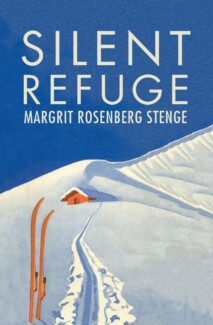Tracks in the Snow
Silent Refuge
Our stay with the Granlis came to an unexpected and abrupt end. In March 1942, the lensmann paid us a visit with some very disturbing news. A German raid of the villages in his district was imminent, and he urged us to leave for Buahaugen immediately. Travelling to Buahaugen at this time of year and with no advanced planning was a terrifying prospect. We did not know how we would manage all by ourselves or how we would get all the necessary provisions. Nils promised to look for someone to bring us what we needed at regular intervals, and we had no choice but to believe him. So on a bright, sunny day, we set out on skis with one of our neighbours, each of us carrying as many supplies as we could.
It took several hours of skiing through deep and heavy snow to reach the seter, but since there were four of us, we made deep tracks in the snow. We hardly recognized Buahaugen when we arrived — the landscape looked like it was frozen in time. Our neighbour helped us carry wood inside and start a fire in the fireplace and the stove to warm up the cottage. And then he left. We were all alone in the great expanse of snow and ice.
The brook was frozen, too, except for a small opening, where we were able to fetch drinking water — on skis, of course. When we needed water with which to wash ourselves and our clothes, we melted snow in a large pot. At night, the cottage got freezing cold, and it was usually my mother who got a fire going before my father and I arose in the morning. We could not go outside without putting our skis on. It was almost inconceivable that we could stay here all alone until the farmers came up for the summer. But that was what we did — at least that was what my parents did.
After a few days in the mountains, I did something that was probably the most selfish thing I have ever done in my whole life. My only excuse is that I was only thirteen years old. I told my parents that I wanted to go back to Rogne, to stay with Nils and Alma and to go to school. Their reaction was predictable. I was their only link to the village in the event that something happened to my father, and now I wanted to leave them completely on their own. In the end, they let me go, provided that I agree to return to the mountains every weekend with provisions.
So I set out on my skis, retracing the tracks we had made a few days earlier. I felt free as a bird — for a little while. Then I began to realize that I was now all alone in the great snowy expanse I had to cover. What would happen if I fell and could not get up?
Silent Refuge, Margrit Rosenberg Stenge
In Oslo, Norway, eleven-year-old Margrit Rosenberg and her parents have been living in safety since fleeing from Nazi Germany in 1938. When Germany invades and occupies Norway in April 1940, the Rosenbergs escape the city and shelter in the small, remote village of Rogne. But anti-Jewish persecution intensifies throughout the country, and the Rosenbergs must find an even more secluded refuge – a small, rudimentary cabin in the mountains. At first, in a landscape frozen in time, the isolation offers relative security and tranquility. But in 1942, as the Nazis begin to arrest and deport the Jews of Oslo, the Rosenbergs are forced to make a fateful decision to trust the Resistance and plan a dangerous escape from Nazi-occupied Norway to neutral Sweden.
Introduction by Robert Ericksen
- At a Glance
- Germany; Norway; Sweden
- Escape
- Hiding
- Postwar Norway
- Arrived in Canada in 1951
- Educational materials available: Margrit Stenge Activity
About the author

Margrit Rosenberg Stenge (1928–2021) was born in Cologne, Germany. After the war, Margrit moved back to Oslo with her family and got married. She and her husband, Stefan, immigrated to Canada, settling in Montreal, in 1951. Margrit worked in administration for forty years, after which she translated six books from Norwegian to English, including Counterfeiter: How a Norwegian Jew Survived the Holocaust by Moritz Nachtstern (2008).
Free Books and Educational Materials
We help teachers bring the subject of the Holocaust into their classrooms, using first-person narratives as a way for students to connect with the history of the Holocaust through survivors’ experiences. Our Holocaust survivor memoirs, educational resources and programming are free of charge and available in both French and English.


